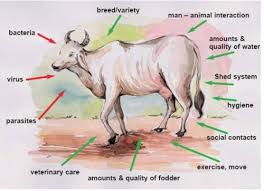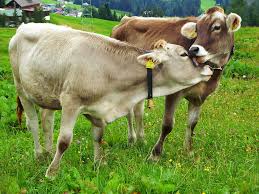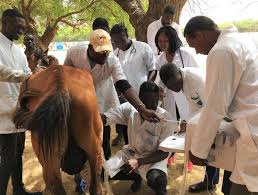Animals that are healthy will perform well and produce maximally for the benefit of man. Diseases generally reduce the performance or productivity of animals, especially food animals (livestock) and ruminants in particular.
It is therefore important that good animal management practices be observed on a farm or wherever animals are kept not just to keep diseases away but for maximum performance.
There are basic terminologies that are used when describing animal health and diseases, and these are to be understood. This article will define or explain certain basic terms used in animal health.
It will also describe how sick animals can be recognized and the action to take in order to determine the cause or aetiology of the disease affecting a sick animal. The objective of this article is given below.
Read Also: Introduction to Rabbit Rearing
Definition of Common Terms Used in Animal Health and Disease Management

An animal is said to be in good health when it is in a complete state of physical, social, and mental well-being and not just that the animal is free from disease.
This means that the animal in question must be adequately cared for with respect to the provision of feed, water, space, a clean environment, etc. An animal that lacks these basic provisions can easily come down with a disease.
Disease is a deviation from the normal and is revealed by changes in the animal. Any animal that has a disease will show some abnormality. This change in the animal can be observed from the behavior, structure, or function of the animal in question.
A sick animal will look dull and weak (lethargy), stay on its own, and refuse to feed (anorexia). A dairy animal that produces milk will have a drop in the quantity of milk produced.
A change in shape in areas of the body structure of a sick animal can also be noticed, depending on the part or organ of the body that is affected. These changes can be major or minor depending on the severity of the disease condition, and they can also be qualitative or quantitative.
The observable changes seen or noticed when an animal is sick are known as symptoms or clinical signs. There are symptoms or clinical signs that are common to most diseases, while some are specific to particular diseases. Some of the common symptoms seen in most diseases include refusal to eat, fever or pyrexia (increase in body temperature), dullness, etc.
The changes observed when an animal is sick form the basis for diagnosis or determining what is causing the sickness in the animal, and diagnosis can be defined as the art and science of determining the nature and causes of diseases and differentiating between diseases.
Components of Diagnosis in Animal Health
To arrive at a diagnosis, some information or facts about the animal must be gathered. The information collected should be as comprehensive as possible, and these can be regarded as components of diagnosis. These include:
1. History taking: This involves gathering information about the animal such as the identity of the animal (species, name or tag number, age, sex, breed, color of the animal, etc.), when the animal was first noticed to have changed in behavior or performance, how long this condition has been on, etc.
2. Physical examination: This is done by observing the animal itself for any sign of abnormality, taking the temperature, pulse rate, and respiratory rate. If this is done on a farm, it can include looking at the housing and environment where the animal is kept, the type of feed given to the animal or animals, etc.
3. Laboratory examination: This is carried out on samples or materials collected from the animal or the environment where the animal is kept. The sample collected is subjected to several laboratory procedures to detect the presence or absence of some disease-causing agents or substances.
Examples of samples collected from a sick animal include blood, faeces, skin scrapings, urine, or even organs of a dead animal (especially where there are many animals on a farm), etc.
Also, some part of the feed given to the animal can be collected for laboratory examination. Laboratory examination of samples collected from sick animals is important in arriving at a definitive diagnosis.
Read Also: 10 Health Benefits of Rabbit Meat
Recognition of Sick Animals in Livestock Farming

Diseases result in a disturbance in the normal behavior, activity, or performance of the animal or animals. In most cases, this change in behavior, activity, or performance can be observed. General signs or symptoms of sick animals are:
1. Anorexia (inappetance): The animal goes off feed or refuses to eat.
2. Fever (pyrexia): This is an increase in body temperature of the animal above normal.
3. Weakness (lethargy): The animal shows signs of tiredness and reduced movement.
4. Depression: The animal appears withdrawn and inactive.
These symptoms or clinical signs may not all be present in all diseases at all times. For example, an animal suffering from helminthosis (worm infestation) may not show fever unless this condition has another concurrent infection.
At this point, it is understood that it is important to keep animals healthy and to explain or define some common terminologies used in animal health. Basic actions that are done to determine the cause of a disease or arrive at a diagnosis have also been identified.
In addition, general observable signs of a sick animal and what samples can be collected from sick animals for further examination to support a correct diagnosis have been discussed.
At this stage, terminologies like disease and diagnosis can be defined or explained, as well as steps used to arrive at the diagnosis of a sick animal. Some general signs of a sick animal can also be mentioned.
In fact, if present on a farm when a veterinary doctor comes to look at a sick animal, some initial or basic things done to determine the cause of the sick animal will now be familiar.
Do you have any questions, suggestions, or contributions? If so, please feel free to use the comment box below to share your thoughts. We also encourage you to kindly share this information with others who might benefit from it. Since we can’t reach everyone at once, we truly appreciate your help in spreading the word. Thank you so much for your support and for sharing!

